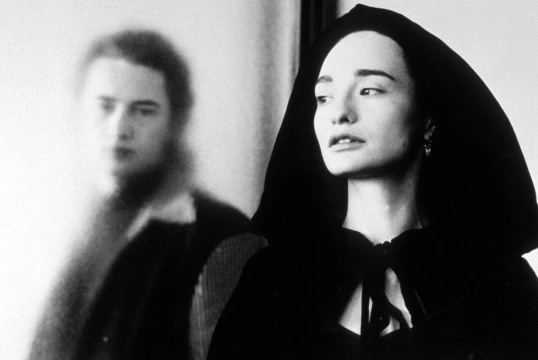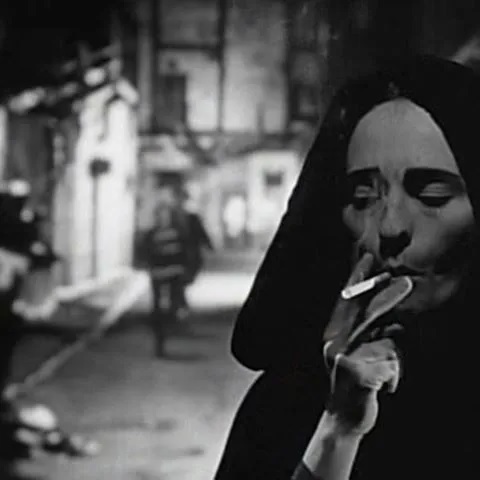Nadja (Reviewed by Lisa Marie Bowman)
When we first meet Nadja (Elina Löwensohn), the title character of this odd, 1994 film, she is walking around New York, wearing a cape and picking up men in bars. She speaks with a thick, Eastern European accent and when she’s asked what she does, she explains that she comes from an old and very wealthy Romanian family. As we quickly guess, Nadja has lived for centuries. She’s a vampire, a daughter of Count Dracula. Everything she says and everything she does is drenched in the ennui of someone who wishes to be set free but who knows she is destined to live forever in the prison of her existence. Even when she has visions of her father getting a stake through the heart, it doesn’t provide her with the relief for which she was hoping.
It probably won’t come as a surprise to learn that it was a member of the Helsing family that drove the stake through Dracula’s heart. However, having killed the vampire, Van Helsing (Peter Fonda) finds himself in trouble with the police. Apparently, the cops don’t believe Van Helsing when he insists that he was just killing a vampire. As far as they can tell, Van Helsing just killed a man with a sharp piece of wood. Fortunately, Van Helsing’s nephew, Jim (Martin Donavon), also lives in New York and can bail his uncle out of jail.
While Jim is dealing with his uncle, Nadja is meeting a woman in a bar, a woman named Lucy (Galaxy Craze). Both Lucy and Nadja feel empty and unfulfilled. Lucy, who happens to be married to Jim, is soon inviting Nadja back to her home and becoming obsessed with her. However, Nadja is more concerned with her brother, Edgar (Jared Harris). Edgar lives in Brooklyn with his lover and nurse, Cassandra (Suzy Amis). When Nadja visits Edgar, she decides to take Cassandra away from him. Of course, Cassandra just happens to be Van Helsing’s daughter and Jim’s cousin!
Nadja is an odd film. On the one hand, it’s pretentious in the way that only a mid-90s, New York art film can be. Director Michael Almereyda shot the majority of film at night and a good deal of it with a PXL-2000, which was basically a toy video camera that was specifically marketed to children. As a result, the black-and-white images are usually dark and grainy. Sometimes, it’s a bit of struggle to tell just what exactly is happening on-screen. And yet, at the same time, it kinda works. Those hazy images, combined with the largely deadpan performances of the cast, give the film an undeniably dream-like feel. When we see Nadja walking through the city, we feel her ennui and otherworldly presence. At its best, the film achieves a hypnotic visual beauty. If ever there was an American city that benefits from being filmed in grainy black-and-white, it’s New York City.
The film plays out like a satire of the typical decadent vampire film. (Nadja even has a Renfield of very own.) Nadja is so obviously a vampire that it’s impossible not to be amused by the fact that hardly anyone else seems to pick up on it. However, the film’s most subversive element is Peter Fonda’s performance as Van Helsing. With his long hair and a demented gleam in his eye, Fonda totally upends all our assumptions about who someone named Van Helsing should be.
In many ways, Nadja plays out like an elaborate inside joke but it’s just strange enough to always be watchable. David Lynch, whose influence is obvious, has a cameo as a morgue attendant and he feels right at home. This deadpan vampire film many not be for everyone but then again, few worthwhile films are.


